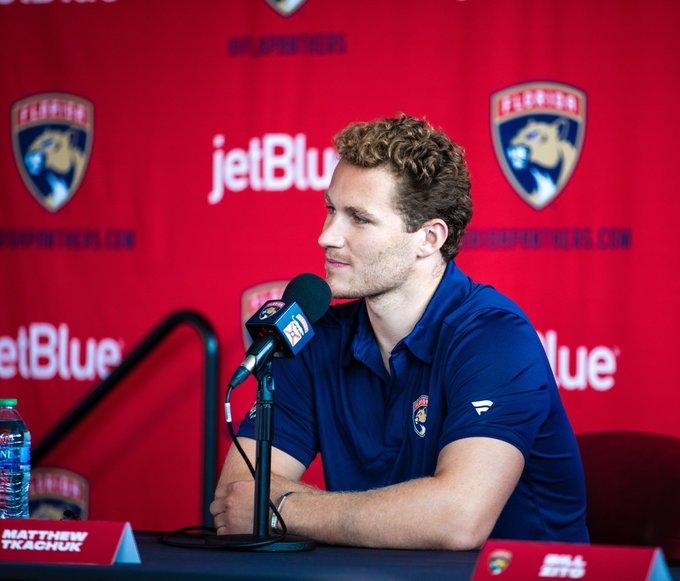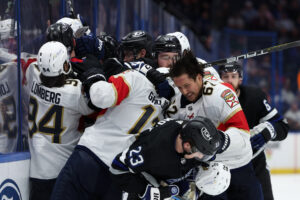On July 22nd, the Florida Panthers and Calgary Flames completed arguably the biggest trade of the salary cap era. The trade saw Matthew Tkachuk leave Calgary, a massive move considering his age and elite star prowess. But in return, the Flames acquired Jonathan Huberdeau and MacKenzie Weegar. Huberdeau finished tied-for-second in scoring across the entire NHL last season, only trailing Connor McDavid. So, needless to say, he’s quite the catch. Weegar is too, after establishing himself as a top pairing, right-shot defenceman over the past couple of seasons. Going the other way, Tkachuk (24) is just entering his prime and may have the highest ceiling of any player in the deal. That being said, Florida gave up two huge players to acquire one huge player. And that’s before also mentioning that they parted with prospect Cole Schwindt and a 2025 first-round draft pick too.
How the Florida Panthers Win the Matthew Tkachuk Trade
So, all-in-all, Florida moved four assets in exchange for two. Besides Tkachuk, they netted a 4th round draft pick in 2025 as well. Many opinions from the hockey community suggest that the trade represented a massive overpayment, even for a ‘generational’ talent like Tkachuk. Florida gave up their franchise’s all-time leader in points and a former first-round pick (Huberdeau) for him. They gave up their second-best defenceman, someone they developed from within (Weegar) for him. Heck, they even gave up a quality prospect (Schwindt) and a future first-round pick for him too. The Panthers are expecting a lot from Tkachuk.
Calgary’s Haul
To put it lightly, a lot has to go right for Florida to be able to justify this move. On the bright side, the deal marked the first-ever “sign-and-trade” deal in NHL history, and Tkachuk arrived in Florida on an eight-year contract. Meanwhile, Huberdeau and Weegar become unrestricted free agents next summer. Worst case scenario for the Flames, both of them walk for nothing in one year’s time. If that occurs, the Tkachuk trade only purchased those two as one-year rentals, but they’d at least still have a prospect and future first-round selection to show for it.
But, even the contract situation remains a puzzle. Huberdeau and Weegar, currently, carry a combined cap hit of $9.15 million. Tkachuk’s new contract hits Florida’s books for $9.5 million per season, for the next eight seasons. He joins Aleksander Barkov as the only Cat signed through 2029-30, an obvious indication of his core role with his new team. But, Florida already sat a few million over the NHL salary cap, so the move only made that situation slightly worse. They have work left to do to become cap compliant by the beginning of the 2022-23 season.
Florida’s Situation, as it Stands Today
To start understanding why general manager Bill Zito made this move, the best method is to look at what they have now as the dust settles. Barkov and Tkachuk remain just the tip of the iceberg on a roster loaded with talent. Sam Reinhart, Anthony Duclair, Sam Bennett, and Carter Verhaeghe all have two to three years left on their contracts. That top six looks scary; each player can score 20, 30 or 40+ goals. Tkachuk finished seventh in league scoring last season, so despite losing Huberdeau, the hope is Tkachuk can more than replace what was lost. After all, Tkachuk enters next season at just 24 years of age.
Duclair has an injury that will force him out of the lineup and onto the long-term injured reserve to begin the season. That buys Florida $3 million in cap relief, at least for now. Unfortunately, that still means another deal must take place, as they sit $3.375 million over the cap. The Tkachuk trade, again, added to the cap problem in the short term. Oh, and Eric Staal will attend camp on a professional tryout; if he signs, that’ll be even more money to clear space for.
Roster-wise, Patric Hornqvist carries a $5.3 million cap hit which expires at the end of the season. If they could move him somewhere, that would not only make them cap compliant but give them a little room to breathe. The rest of their depth rests with young players on low-cost deals, most of whom will be RFA’s upon expiration. Those players probably stay in place, as Florida needs all the affordable options they can get right now.
Panthers Looking a Little Thin on Defence
On defence, the picture remains less clear. Weegar played both sides of the ice in Florida, typically lining up on the left despite shooting right. He paired with Aaron Ekblad typically, on the team’s top pair. Now, they likely slide a left-handed shot up to play with Ekblad, a more natural fit. Perhaps Gustav Forsling receives the opportunity to fill those shoes.
Regardless of which lefty plays with Ekblad, “more natural” certainly doesn’t equal “better”. Interestingly enough, though, the team actually remains short when it comes to right-handed blueliners. Besides Ekblad, they only have Brandon Montour and Radko Gudas who shoot right. Out of their nine currently-non-roster defencemen, only prospect Santtu Kinnunen (who?) shoots right too.
So, it appears a lefty will be flipped at some point to play on the right side eventually this season. Florida did add a couple more defencemen, though they both shoot left as well. Michael Del Zotto might be the X-factor, after signing a one-year deal. His possession metrics this past season were actually his best since 2010-11, his sophomore season in the NHL. Then, they grabbed Marc Staal too, who did not produce the same sort of trendy statistics that Del Zotto did. Those defencemen add depth, but certainly don’t replace Weegar’s impact.
What Justifies the Tkachuk Trade for Florida?
The Tkachuk trade impacted every area possible for this Panthers team. They lost Huberdeau, a face of the franchise, but replaced him with`q another. It also took a top defenceman, shaking up their pairings dramatically. And, of course, there’s the prospect and first-round pick. The value lost there will take time to evaluate, but Schwindt is held in high regard as a solid prospect. And first-round picks definitely hold plenty of value too; Florida doesn’t have any now until 2026.
That means, despite what they gave up, the Panthers still see themselves as contenders. And rightfully so; they still wield all sorts of talent. And Tkachuk absolutely brings a physical, gritty, nasty edge that the team was missing. Yes, Lomberg plays the pest role well. So does Hornqvist. But, neither of those two can play 20+ minutes a night, nor can they produce at a point-per-game pace. Tkachuk can do it all, and that edge should do a lot for Florida. They hope it will truly bear its fruit in the postseason, too.
Making Sense of the Money Side
Financially, they remain in a bit of a pickle. But, they no longer have to stress over figuring out how to afford Weegar and Huberdeau next summer when they reach free agency. That’s Calgary’s problem now. Instead, Florida will only see non-core players reach UFA status, plus some $5 million in buyout penalties fall off the books. Some of that will go towards their RFA’s, potentially. Spencer Knight is the most notable of that group, while the others must prove themselves this year.
If Florida goes deeper into the playoffs this year than they did last, the trade will look better than it does today. The better this team performs, or if they can win even one Stanley Cup with Tkachuk in the fold, the deal will go down as a win. It also wouldn’t hurt the trade’s justification if either Huderdeau and/or Weegar walked away from the Flames next summer. Huberdeau certainly can obtain more than Tkachuk’s $9.5 million salary on the open market. And Weegar just needs to maintain his play, and he could receive a $6-8 million annual cap hit. Florida, without a doubt, could not have afforded both of those deals next summer without tons of side work.
Florida still might need to pull one more rabbit out of their hat to get under the cap this year, but it sure gets easier next year. That should raise eyebrows around the league, as their core will all stay put. Give Zito another $12-14 million in cap space? They’re already a force to be reckoned with. They should only get scarier.
Your newest Florida Panther, Matthew Tkachuk, on coming to South Florida:
“I want to win. I have the hunger to win. And I know everyone else in there does too.” pic.twitter.com/3cpVmk7piH
— Florida Panthers (@FlaPanthers) July 25, 2022






